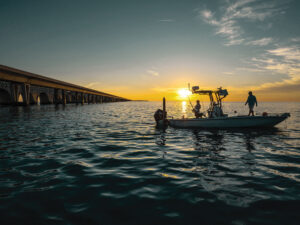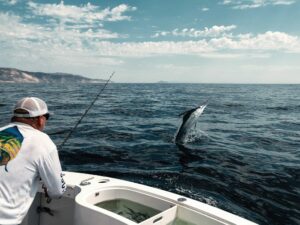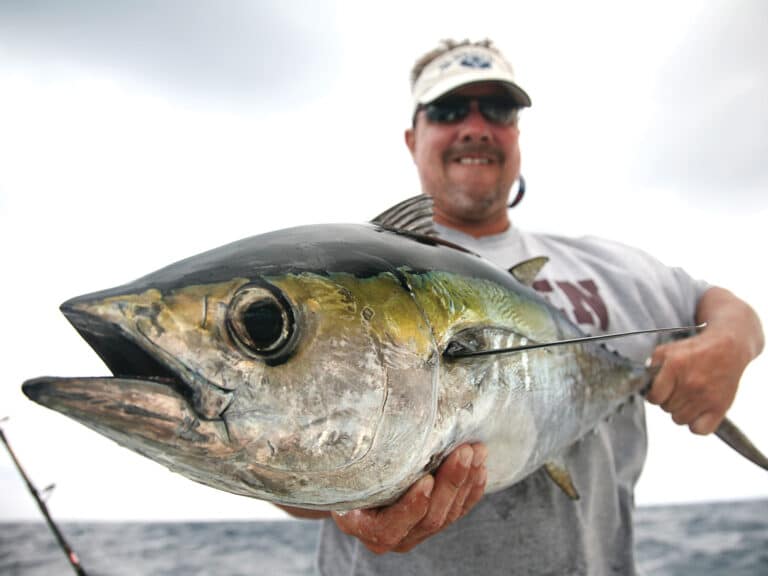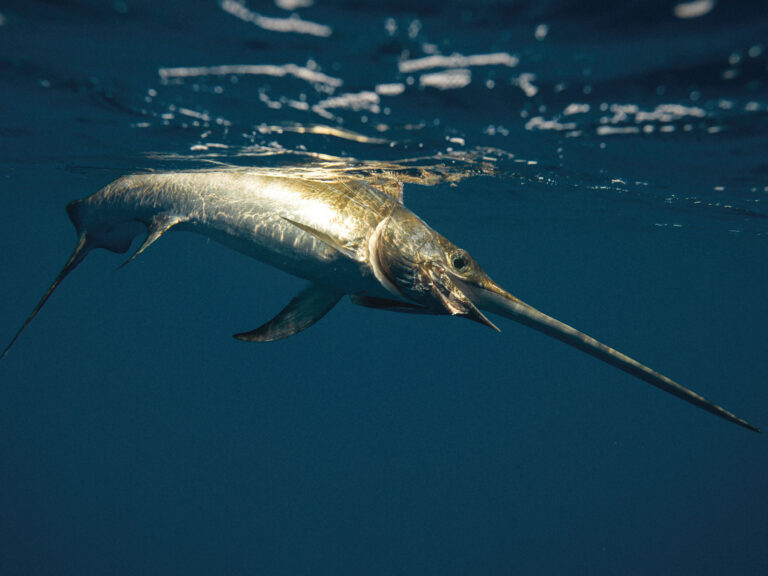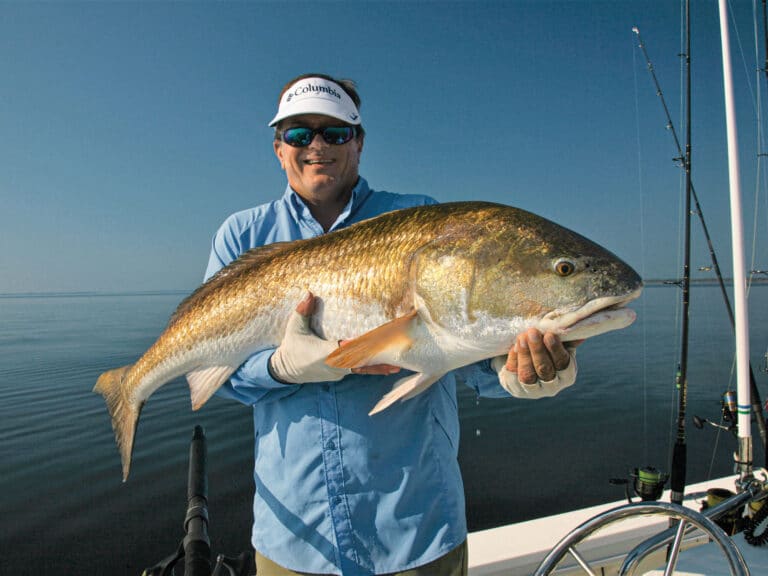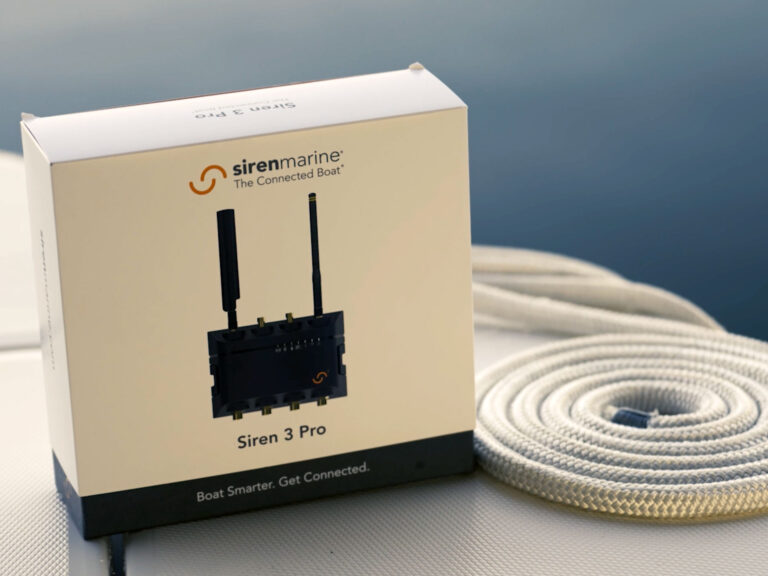
In March 1997, Capt. Mitch McFrederick took Billy Pate and me fly fishing for Hatteras’ winter bluefin tuna. The weather was pretty inhospitable, and we didn’t see any fish. We did, however, agree that we ought to consider trying some of Oregon Inlet’s white marlin if they started to bite like they had the previous fall. Like most plans made over a beer and a bad fishing trip, they were not subject to serious legal commitment.
I had not given much thought to the deal when McFrederick called and said he was going to spend August and September at the Oregon Inlet Fishing Center and that I should come up with a fly rod. McFrederick and his mate John Oughton had not fly-fished previously, but they were ready to learn. With my three days in Guatemala for experience, I hardly qualified as a fly-rod expert. That job fell to Tyler Stone, co-owner of Intracoastal Angler, a fly shop in my hometown of Wrightsville Beach. Beginning fly angler Shannon Redman rounded out the crew.
As mentioned earlier, our first day was a little messy, but we had the chance to make amends at around 9:30 a.m. on the second trip when we raised a 400-plus-pound blue. I was holding my fly rod and fly ready when the fish showed, but the 80-pound outfit we had in the corner of the cockpit was rigged with a swimming mullet and seemed a little more appropriate for the highly irate animal eating our teasers to shreds. As fate would have it, though, the fish came up in range on the Hawaiian Eye chain, giving me the opportunity, if I wanted it. McFrederick pulled the boat out of gear. “Try him, buddy. Try him.”
So I did.
What happened next changed my ideas about a successful fishing trip forever. The fish saw my fly and turned immediately to it, moving from port to starboard with its dorsal and bill out of the water. As the fly sank, I stripped once, and the fish followed it down and ate it. I struck three times and felt the marlin start shaking its head when the hooks bit. Then it decided to change zip codes.
The fish went straight away and straight up four times, landing with a big splash into the calm sea. Somewhere into the fourth jump, my 16-pound tippet came into contact with something incompatible to monofilament of that size and broke. Such a parting is not normally the cause for celebration, but we reacted like we had just won the World Series.
Three hours later, I was eyeball to eyeball with a white marlin that Oughton had teased to the transom. My fly landed in the right spot and the fish ate it, setting off one of the hottest aerial displays that I have seen in a long time. Maybe Ernest Hemingway could do the affair justice, but I will just say it ranks as one of my top five days on the ocean and leave it at that. In any case, I got the nail knot into the rod tip in around 20 minutes, and we successfully released our fish.
So What?
What’s the big deal? Believe it or not, as far as I’ve been able to tell, that little white marlin was the first billfish caught on a fly rod north of Florida since Chico Fernandez caught a white out of Oregon Inlet way back in the 1960s. While fly-fishing tackle sales continue to enjoy steady growth, evidently not too many fishermen are using that tackle in their own back yard.
True, offshore fly fishing requires a good number of shots per day to be anything more than a nuisance. But in the right season, the U.S. coastline offers several areas where fly fishing can and should be practiced more.
A boat employing fly tackle for billfish can obviously be successful at Oregon Inlet during the white marlin bite of August and September. There are days when boats will see as many as 20 or 30 fish raised to trolling spreads, although a visiting angler should not go there expecting that to be the norm. A more realistic expectation would be to see three or four whites in a day, but don’t be tremendously surprised if you see as many as 10 or as few as one.
“We raised eight fish, successfully teased four, hooked two and caught one in 10 hours of fishing,” Stone says. “In those two days, we were never on a hot bite. The thing that occurs to me is that with a competent crew and the kind of hot bite that you can have at Oregon Inlet, fly fishing could be as good as it is anywhere in the world.”
With that idea in mind, McFrederick and Oughton plan on concentrating on fly fishing in the fall, and more charter boats will likely follow that path if they find continued success.
By no means does the potential for fly-rod billfish action stop at the North Carolina borders. The potential for south Florida’s sailfish fishery is so obvious that it does not require much of a sales job, and white marlin certainly exist in teasable numbers as far north as Martha’s Vineyard. All that stands between someone catching them there on fly rods is going out and doing it.
Another thought for the Mid-Atlantic is the blue marlin fishing off North Carolina in the summer. Hatteras, Morehead City and Oregon Inlet all have excellent blue marlin fishing, and someone who is serious enough about the long rod could do worse than fish there when the conditions are right.
“June and July are good months to try it at Hatteras,” McFrederick says. “If the conditions are right, the fish will be there and, on slower days, a bait-and-switch strategy could be good with the option to use conventional tackle if the fish was really big or just wouldn’t respond to the teasers.”
If there was ever a billfish made for fly rods, the striped marlin is it. While Southern California can’t boast the number of shots that destinations south of the border can, a home-bound angler can still get plenty of chances there – especially in El Niqo years. In these waters, the angler would cast a fly to a finning fish just as conventional live-baiters do. If the fish were sluggish, a hookless bait teaser could be employed to wake up the sleepers prior to the fly cast.
How to Do It
The techniques involved in fly fishing for billfish have been covered in numerous ways, though most crews still view the elaborate leaders and teasing techniques as more trouble than they’re worth. Yet any capable billfish crew can get up to speed with a little practice, a little homework and a little patience. Why bother? Because this form of fishing beats any other when it comes to interaction with the fish.
Setting up a crew to begin fly fishing for billfish is actually simple. Start with your spread. Fly fishing requires trolling teasers in an attractive spread while still allowing the angler room to cast, so one rigger (the one to port for right-handed casters) is left up and not used. Use just four teasers – three off the starboard rigger and one from the flat-line position opposite the rigger.
What happens after you see the fish is what makes fly fishing worth the extra effort. If the fish is a sailfish, you can generally take it off your rigger teasers with the flat-line teaser, usually a natural belly strip that gives you the ability to better control the situation. Allow the fish to eat just enough of the strip to bring it to a frenzy, drawing it to the transom at the same time. Once within range, pull the teaser out of the water, take the boat out of gear and make your cast. The fish will (should/might) eat the fly going away, giving the angler the best opportunity for the hook-set.
With a white or blue marlin, the action is going to be faster than described above, and such a straightforward approach won’t work every time. In these situations, try bringing all of the teasers closer to the boat (as opposed to using just the belly strip to keep the fish occupied). This will keep blues and whites moving toward the boat and give you a better chance to get your shot.


